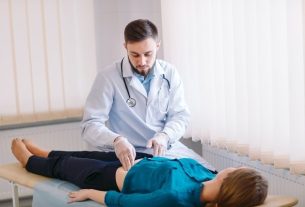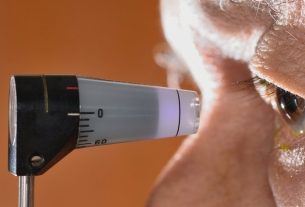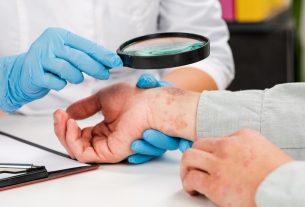The main symptoms of meningitis are a high and sudden fever, severe headache, pain and difficulty moving the neck and touching the chin to the chest area, as well as greater sensitivity to light and noise and mental confusion.
Meningitis is the inflammation of the membranes surrounding the brain and can be caused by viruses, bacteria, fungi or parasites, as well as non-infectious agents, such as trauma caused by strong blows to the head, for example.
In the presence of signs and symptoms possibly indicative of meningitis, it is important that the general practitioner, infectologist or neurologist is consulted so that symptoms can be assessed and tests can be carried out to help confirm the infection and the cause of meningitis, being then it is possible to start the most appropriate treatment. Find out more about meningitis and its causes.

Main symptoms
The main symptoms of meningitis are:
- High and sudden fever;
- Severe headache that doesn’t go away;
- Nausea and vomiting;
- Pain and difficulty moving the neck;
- Dizziness and difficulty concentrating;
- Mental confusion;
- Difficulty placing the chin on the chest;
- Sensitivity to light and noise;
- Drowsiness and tiredness;
- Lack of appetite and thirst.
Symptoms of meningitis can appear between 2 and 10 days after contact with the infectious agent, however it is more common to occur between 3 and 4 days after infection. Learn how to identify the symptoms of meningitis in the following video:
Symptoms in the baby
In babies under 2 years of age, in addition to high fever, important signs and symptoms include:
- Constant crying;
- Irritability;
- Somnolence;
- Lack of enthusiasm;
- Lack of appetite;
- Stiffness in the body and neck.
In the case of babies under 1 year of age and with the fontanelle still soft, the top of the head may become swollen, making it appear as if the baby has a bump due to a blow. Furthermore, in the case of meningococcal meningitis, it is also possible to notice the appearance of red spots on the skin, convulsions and paralysis, for example.
Online symptom test
To find out if you have meningitis, please select the symptoms you present:
This test is a tool that serves as a means of guidance only. Therefore, it is not intended to provide a diagnosis and does not replace consultation with an infectious disease specialist, neurologist or general practitioner.
Who is most at risk
People who are at greatest risk of meningitis are those who have a weakened immune system, whether due to age, as in the case of babies and the elderly, or to chronic illnesses and infections. This is because under these conditions the immune system is unable to act effectively against the infectious agent, resulting in a greater chance of meningitis inflammation and the development of the disease.
How to confirm meningitis
The initial diagnosis of meningitis is made by the doctor based on the assessment of the signs and symptoms presented by the person, and a physical assessment may also be carried out, which consists of movements with the neck to check whether there is pain or discomfort, since the Neck stiffness is present in virtually all cases of meningitis.
To confirm the diagnosis of meningitis, a culture of cerebrospinal fluid, also called CSF, is normally indicated, which is done by collecting this liquid through a lumbar puncture. By analyzing this material, it is possible to check whether there are bacteria, viruses, parasites or fungi that may be related to inflammation of the meninges.
The doctor may also recommend additional tests such as blood, urine and imaging tests, such as computed tomography or magnetic resonance imaging.
If you wish, make an appointment with your nearest doctor to assess the possibility of meningitis:
Taking care of your health has never been easier!
How the treatment is carried out
Treatment against meningitis is carried out in hospital with the use of medications according to the agent causing the disease, and the use of antibiotics, antifungals, antiparasitics or antivirals may be indicated.
Carrying out treatment in the hospital is important so that the person’s vital signs are monitored, to prevent complications and to monitor the effectiveness of the treatment, as it may be necessary to change the dose in order to promote the elimination of the infectious agent. more effectively.
How to avoid
The main way to avoid meningitis is through the vaccine, which protects against various forms of the disease and is recommended for newborns and children up to 12 years of age. Check out the vaccines that protect against meningitis.
In addition, washing your hands frequently and keeping environments well ventilated and clean also helps prevent the transmission of meningitis.
Bibliography
- HEALTH SURVEILLANCE SECRETARIAT | MINISTRY OF HEALTH. Unspecified bacterial meningitis in Brazil 2007 – 2016: challenge for meningitis surveillance. 2019. Available at: <http://www.saude.gov.br/images/pdf/2019/fevereiro/01/2018-038.pdf>. Accessed on 15 Jul 2020
- DIAS, Fellipe et al. Meningitis: epidemiological aspects of the disease in the northern region of Brazil . Journal of Pathology of Tocantins. Vol. 4 No. 2. 46-49, 2017
- EPIDEMIOLOGICAL BULLETIN: MENINGITIS. Government of the state of Paraná, Department of Health . 2018. Available at: <https://www.saude.ce.gov.br/wp-content/uploads/sites/9/2018/06/boletim_meningites_30_05_2018.pdf>. Accessed on 15 Jul 2020
- Meningitis: what it is, causes, symptoms, treatment, diagnosis and prevention. Available at: <http://www.saude.gov.br/saude-de-az/meningites>. Accessed on 15 Jul 2020

Sign up for our newsletter and stay up to date with exclusive news
that can transform your routine!
Warning: Undefined array key "title" in /home/storelat/public_html/wp-content/plugins/link-whisper-premium/templates/frontend/related-posts.php on line 12
Warning: Undefined array key "title_tag" in /home/storelat/public_html/wp-content/plugins/link-whisper-premium/templates/frontend/related-posts.php on line 13





